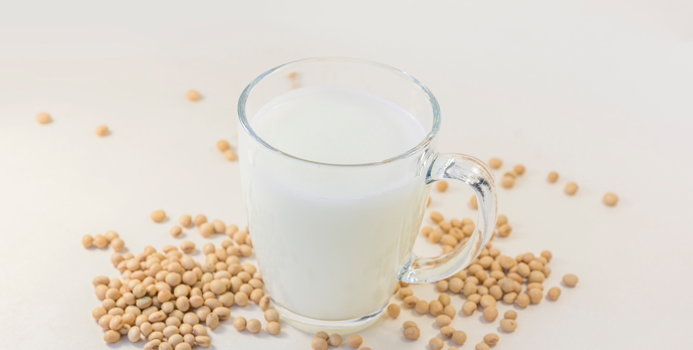For people who have problems digesting lactose, or for vegans who don’t want to consume animal products, there are several non-dairy milk options that are readily available in grocery stores today.
These options are ranked by their ability to closely replicate milk’s nutrient content, in terms of its benefits: protein and calcium. Milk is also a good source of vitamin D, but not naturally — it's supplemented in the U.S. This ranking is somewhat subjective — if you are using non-dairy milks for a specific reason, you may want to choose the option with higher unsaturated fats or the lowest amount of sugar.
Non-dairy milks are typically made by soaking and/or blending the main ingredient with water and straining the liquid out to use as milk. This does create food waste as the leftover pulp is discarded. However, if you decide to make any of these at home, you could easily reuse the pulp. Additives are necessary to preserve the milk, and some alternatives contain thickeners to recreate the creamy texture of cow’s milk.
Soy
Soy milk is still the best alternative to cow’s milk in terms of its ability to replicate milk’s nutrient content, despite the many new non-dairy options available. It is about the same amount of calories per cup and provides more protein than any of these other options.
Soy does have its disadvantages if you are concerned about the number of phytoestrogens you are consuming. Phytoestrogens are naturally occurring compounds that are found in a variety of plant foods such as beans, seeds, and grains, but soybeans are the major dietary source. The chemical structure resembles estrogen and may affect the production and/or the breakdown of estrogen by the body, as well as the levels of estrogen carried in the bloodstream. Unfortunately, the result of high phytoestrogen intake is unpredictable, partly due to a poor understanding of exactly how they work in the body. Ask your doctor if there is any concern for consuming soy products, or limit intake of soy milk to 3-4 cups/week.
Oat
Oat milk does a fairly good job of providing a comparable alternative in terms of calcium and fat, making it the second best alternative to cow’s milk. It has half the amount of protein — and more sugar — so oat milk should be limited to avoid too much sugar consumption.
Rice
Rice milk is comparable to cow’s milk in terms of calories and fat but has very little protein and calcium. If you are choosing non-dairy milk because you are vegetarian or vegan, make sure to get enough protein and calcium from other sources or supplementation.
Almond/Cashew
Almond and cashew milk have very similar nutrient breakdowns. They have less than half the calories per cup of cow’s milk, which is perhaps why almond milk is so popular. They have little-saturated fat and no sugar, which is a great reason to try these nut milks.
Hemp
Hemp milk is relatively rare but offers a good amount of unsaturated fats, which are generally low in the western diet.
Quinoa
Quinoa milk has very little fat, protein, or sugar. Choose quinoa milk if you prefer the taste over the above options; but, if possible, choose another milk that provides more protein.
Coconut
Coconut milk is higher in saturated fat and has no protein. However, it has little sugar and may provide a creamy texture that the other options lack.
|
Milk Ingredient |
Calories per 1 cup |
Fat (Saturated Fat) g per 1 cup |
Protein per 1 cup (g) |
Calcium per 1 cup (% Daily Value) |
Sugar per 1 cup (g) |
|
1% Cow’s Milk |
102 |
2 (2) |
8 |
30% |
13 |
|
Soy |
108 |
4 (1) |
6 |
29% |
9 |
|
Oat |
130 |
2.5 (0) |
4 |
35% |
19 |
|
Rice |
120 |
2.5 (0) |
1 |
2% |
10 |
|
Almond |
37 |
3 (0) |
1 |
48% |
0 |
|
Cashew |
40 |
3 (0.5) |
1 |
30% |
0 |
|
Hemp |
60 |
4.5 (0) |
3 |
20% |
0 |
|
Quinoa |
70 |
1 (0) |
2 |
30% |
2 |
|
Coconut |
45 |
4 (3.5) |
0 |
45% |
1 |
No matter what option you choose, make sure you like it! Buy what tastes good to you, however, you are using it — in coffee, with breakfast cereal, in baking, etc. The milks compared above are all unsweetened, unflavored varieties. There are now many flavors available to make these non-dairy choices more appealing. Be sure to read the nutrition facts label to avoid consuming a lot of added sugars.
There are also other options, like macadamia and hazelnut, that are not widely available but may be a good option if you don’t like the taste of any of the above listed. If you have allergies or Celiac Disease, check the ingredients carefully.
Nutrient Info taken from the USDA or product websites — popular brands are Dream and Silk.
[Image via Shutterstock]



